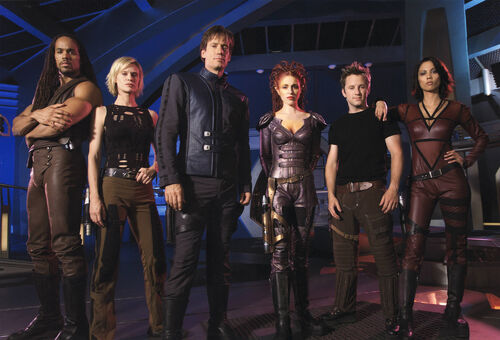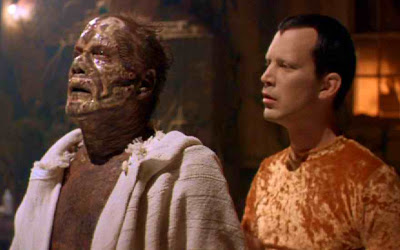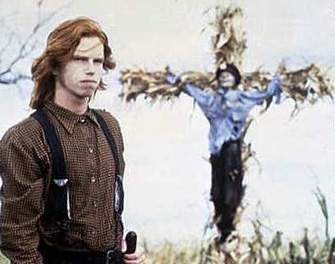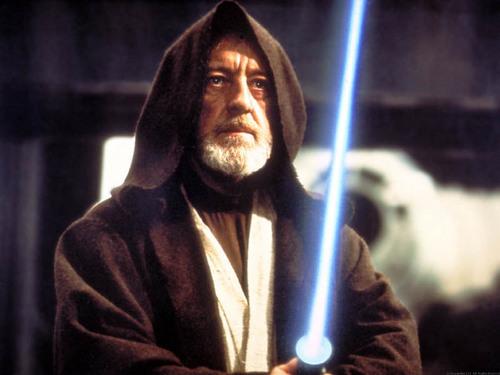The Top 10 Imaginary Religions Created For Sci-Fi
Christmas is nearly upon us. Chanukah was last week. The winter Solstice just occurred. We are surrounded by holidays of varying stripes. Thanks to the diversity of religions on this planet, we have a wondrous dearth of things to celebrate. With every holy walk of life comes a slew of holy days, many of which involve either giving gifts, or perhaps just getting blitzed and singling the “Five Golden Rings” line from “The Twelve Days of Christmas” as loudly and as off-key as possible.
Some of the hard-working film and TV writers of the world, though, in fits of theological pique, have devised many imaginary religions for us to ponder. Some are belief systems of the future; as people change, and churches fracture, it’s entirely possible that new religions will spring up. Some are smaller cult-like religions, bent on the destruction of mankind, but something tells me that the celebrations in such cults would be wonderfully debauched evenings to rival your most debauched New Year’s parties. At least until you’re selected for the sacrifice.
Here then, are the top ten imaginary religions.
10) The Nietzscheans
from “Andromeda” (2000 – 2005)

Friedrich Nietzsche is one of the least understood and most misinterpreted philosophers of his generation. What most people (who haven’t read much of his works) remember is that he wrote books with titles like Why I Am so Wise, and promoted ideas of The Will to Power, placing superior “master” minds over weaker, complacent “herd” minds. This led laymen to believe that he was in favor of egoism and domination of the strong over the weak.
The Nietzscheans in Gene Roddenberry’s middling sci-fi space opera “Andromeda” took this idea of Social Darwinism, and worked it into their very genetic code; they enhanced themselves to match Nietzsche’s idea of the überman, and operate from a social position of calm, knowing authority. The show may have been only fair, but these religious followers of Friedrich Nietzsche was a cute little intellectual bone thrown to the philosophy nerds in the audience.
Nietzsche famously declared that God was dead, which makes a religion based around his philosophy extra ironic. What fun.
9) The Cult of Nix
from “Lord of Illusions” (1995)

Horror films are rife with dangerous satanic cults (indeed, there are more awaiting on this list), but there are a few standouts amongst the tribes of robe-wearing, candle-waving chanters. One of the most notable is, I feel, the cult of Nix from Clive Barker’s underrated 1995 feature film “Lord of Illusions.” This was a cult of weirdos who actually seemed personable and dangerous and wicked cool.
Nix (Daniel von Bargen) was a hard-working magician of the old stripe. He was a dirty, fat guy – hardly an intellectual – who used his simple powers of juggling fire and levitating to rope a group of sex-minded ’70s swingers into following him. He would give prophecies about the coming of The Puritan. That is until one of his cultists rose up against him, and buried him alive. Oops.
Nix was pretty scary in and of himself, but “Lord of Illusions” bothers to follow the backstories of some of his followers, and we find that they are a quietly menacing bunch of larval homicidal maniacs. In a simple montage late in the film, we see Nix’s followers casually killing their bosses and families, only to return, years after the fact, to the Nix compound to continue the blood-soaked orgies they once had.
As far and dangerous cults go, the Nix cult is one you don’t want to fuck with.
8) The Church of Tommy
from “Tommy” (1975)

See me. Feel me. Touch me. Heal Me.
When Tommy Walker (The Who guitarist Roger Daltrey) was a young boy, he accidentally saw his mother (Ann-Margret) and her friend (Oliver Reed) making out in a bedroom. They were concerned about their secret getting out, and insisted that he saw and heard nothing, and will say nothing. As a result, Tommy became hysterically blind, deaf and dumb. He lived this way into adulthood, becoming, naturally, a pinball champion. When he spontaneously regained his senses one afternoon, he was already a hugely admired cult-leader-like pop icon, and decided to use his powers to promote peace love and understanding. The only price of admission was that you had to wear blinders, earplugs and gags, and learn to be pinball wizards yourselves.
The Who’s psychedelic rock opera is an epic, queasy experience as it is, with themes of love, drugs, religion, familial control, consumerism, and features not only a scene in which Jack Nicholson sings, but also is infamous for the scene in which Ann-Margret writhes around sexually in a gloppy bog of baked beans.
When you heap a worldwide cult on top of this psycho malaise, it makes that cult seem all the more whacked-out. For a delirious few moments while watching “Tommy,” you may find yourself actually understanding the backward dream logic of joining a cult about blind pinball wizardry. You get to play pinball AND achieve enlightenment? Sign me up!
7) The various religions from “Dune”
from Dune (1965)

Frank Herbert, in his seminal sci-fi novel, invented what is probably the single most complicated sci-fi canon in the genre’s pop history. He not only invented several different galactic cultures, complete with religions, politics, and social mores, but the political conflicts that they experienced when exposed to one another. If you read the book, you may find yourself glancing at the enclosed glossary frequently.
The most notable religion is that followed by The Fremen, the desert-dwelling people of Arrakis. They worship the colossal underground worm monsters that dwell in the desert, and incorporate the worm’s excretions into their religious rites. They have a messiah mythology, and pray for the time when the Kwisatz Haderach will arise. Like most of the religions in the Dune universe, this is a somber and serious one.
There are also a race of psychic witches wandering around the margins called the Bene Gesserit, who are keen on messianic figures, but are often hired by local royalty to read minds on their behalf. There are also mentally imprinted soul-slave Mentats, a race of Spice-mutated space travelers, and Paul knows what else. As the series of books continue, and the centuries of history begin to pile up, we’re introduced to newer and newer sects of these religions, and we get to see a well-though out (if not totally bugnuts insane) history of these imaginary religions.
No mere afterthought, these ar eimaginary religions with actual theological history.
6) He Who Walks Behind the Rows
from “The Children of the Corn” (1977, 1984)

I have not read the original 1977 Stephen King short story of “The Children of the Corn,” but I have seen the Fritz Kiersch 1984 feature film based on it. This was a story that took some and-the-child-shall-lead conceits previously seen in countless short stories and episodes of “Star Trek,” and brought it them to dizzyingly horrific extremes. These are some other dangerous kids whom you don’t want to mess with.
In the film version, a happy married couple (Peter Horton and Linda Hamilton) find themselves lost in the middle of Nebraska in a town called Gatlin. Gatlin is a weird little town, as there don’t seem to be any adults around. Indeed, the children of Gatlin seem to be up to something, what with their weirdly upbeat blood rituals in convenience stores, and their constant talk of “He Who Walks Behind the Rows.”
It turns out that a boy preacher named Isaac (John Franklin) and his rock-stupid lieutenant Malachi (Courtney Gains) have been communing with an unseen monster who lives in the local corn fields. It’s unclear if the monster is actually telling them what to do, of if these kids just took the initiative, but either way, they have taken it upon themselves to kill every adult they encounter, and then commit suicide after they live just barely long enough to reproduce. I’m willing to bet that most alienated teenager, at least for a glimmering moment, would entertain such a dark fantasy.
As the “Children of the Corn” films continued, we did eventually see He Who Walks Behind the Rows (first in part III), and it turns out it was a giant gopher monster. I think I liked it better when it was unseen.
5) The Followers of Zardoz
from “Zardoz” (1974)
If you’ve been looking for the 1970s braintrip, big-budget experimental cult film that will creepily touch the swimsuit area of your brain, then John Boorman’s “Zardoz” is the film for you. It’s a sci-fi film about a dangerous, barrel-chested savage (Sean Connery), that breaks into a futuristic compound of Eloi-like immortals, who have grown wispy and complacent, thanks to their immortality technology. A clash of personalities ensues, although its depicted in a series of largely unconnected psychedelic imagery that’ll leave you punching your own skull.
The cult in the film is the cult of the titular Zardoz. Zardoz is a large floating stone head that lays decrees to the savages below. The savages scream prayers to the floating head, and make requests. The stone head coughs up guns. The savages rape and kill at Zardoz’ behest. Zardoz then floats away.
Spoiler alert: It turns out that Zardoz is being controlled by a bored immortal who is just playing games with the savages for his own theological amusement. He got the name of his godhead from an old book. The WiZARD of OZ. The film was already crazy enough, and the cult nonsensical. The added bonus of this bourgeois complacency only kicks the Zardoz cult up a few notches on this list.
4) The Bomb Worshipers
from “Beneath the Planet of the Apes” (1970)
The 1968 original “Planet of the Apes,” is an unargued cinematic classic. It perfectly balances the serious conceits of its sci-fi with the ridiculous images of intelligent talking apes. Its 1970s follow-up “Beneath the Planet of the Apes” is not as strong, but goes a little further in terms of its mindfudgery, and introduces us to one of the best cults in sci-fi history.
Taylor (Charlton Heston) finds a mysterious passageway into the center of the planet of the apes, which he now knows is Earth in the distant future. Meanwhile another human astronaut named John Brent (James Franciscus) from centuries past has landed on the planet, and he finds himself in a similar pickle that Taylor found himself in the last film. It’s not long before John and the apes find themselves searching for Taylor beneath the planet’s surface.
Of course, what they find is unexpected. It turns out there’s a race of highly-evolved, ghoulish human being in robes, with telekinetic powers living beneath the planet’s surface. They are a hateful, sterile lot, and aim to kill the intruders. They have taken spiritual consolation in worshiping – get this – an unexploded nuclear bomb left over from the wars that originally wiped out the humans. I suppose if the bomb imagery from the first film was too subtle, you have “Beneath the Planet of the Apes” for your enjoyment.
A bomb cult of mutant superpowered humans. This is why we go to the movies.
3) Jedi
from “Star Wars” (1977)

What list of imaginary religions would be complete without mention of The Jedi from the “Star Wars” movies? Here we have a race of telekinetic warrior monks, complete with otherworldly light swords, who are barely keeping the faith in The Force alive through the crushing grip of a tyrannical galactic empire. This is the stuff of ancient sci-fi novels, and joyous afternoon serials, taken to a grander extreme. Not a sci-fi geek in the world doesn’t love Jedi.
Indeed, the power of the Jedi has become so popular that some people have tried to start actual Jedi churches. There was even an urban myth floating around at one point how, in certain states, if you filled out “Jedi” as your religion on your DMV applications, then the state would have to recognize it as an official religion. Unfortunately for thousands of “Star Wars” fans, this is not true. Although, there are plenty of wonderfully weird-ass real-life religions you can put on official documents. Look up The Church of the SubGenius sometime.
As a theology, Jediism is pretty weak; it’s essentially a simplified combination of pantheism and Buddhism. As a kick-ass space warrior philosophy in a series of popular sci-fi movies, though, it is first rate.
2) The Church of Robotolgy
from “Futurama” (1999 – )

The Church of Robotology is essentially a robots-only version of certain Pentecostal churches of today. There’s the usual preaching, the usual churches, and the usual sermons, only its populated entirely by robots. I love the thinking behind a race of man-made machines needing to worship. Everyone needs spiritual and moral guidance, I suppose, even if it’s a pile of foul-mouthed machines.
This conceit is entertaining enough, but The Church of Robotology does more than just promise a Hell for sinners, and has actually built a working Robot Hell, and an immortal Robot Devil (played gleefully by Dan Castellanetta), to actually physically damn its sinners. This may seem like a point against it, but I am so very tickled by the concept of a Robot Hell, that I had to include it very high on this list.
What’s more, Robot Hell is less like a Dante story, and more like escaped scenes from “Forbidden Zone.” There are peppy musical numbers, musical challenges to the devil, and wicked looking robot monsters lurking around every corner. I don’t think I’d like the robot tortures in Robot Hell, but it seems like a fun place to visit.
1) The Cult of Cthulhu
from “The Call of Cthulhu” (1926)

Ia! Ia! Cthulhu fhtagn! Say that ten times fast.
H.P. Lovecraft was a bitter, reclusive, racist, henpecked atheist living in his aunt’s attic. He was frequently ill, and rarely left his room. He was also one of the best fantasy authors of the age, having created a series of flowery, pungent tales of ancient inhuman gods who were only biding their time until they could reclaim the Earth, and wipe out the humans in their wake. Lovecraft’s prose is, like Shakespeare, eager to be read. Yes, I just compared Lovecraft to Shakespeare.
His elder gods were not, however, mere monsters of the week. In reading all of his tales (but most notably The Lurker at the Threshold, which he wrote with friend August Derleth), you begin to discover a complicated mythology of interconnected mosters, complete with a workable hierarchy of madness-inducing superlogic and unnamable superpowers. While it wasn’t the most powerful of the elder god, Cthulhu (pronounced like a gutteral expectoration) was certainly the most popular.
Cthulhu is a giant, gelatinous, octopoidal bat creature who hides behind a large stone gate out in the middle of the sea. Luckily for the monster, there are a race of backwoods weirdos living in Louisiana who gather regularly to invoke ancient, near-unpronouncable texts, burn sacrifices, and be generally unapprochably creepy. They long for the days when the elder gods will return, this group of largely-unseen maniacs, and they have a regular debaucherous walpurgisnacht to celebrate the coming. It’s like the Christmas of Cthulhu.
Fantasy literature is peppered with wicked cults and Satan worshipers, but Lovecraft managed to codify and exemplify just what a crazy backward cult should be worshiping. They are the best cult in literature.

And what would YOU like from R’Lyeh?
N.B. If anyone can explain the theology behind the Transformers, Please explain it to me.
Witney Seibold is a churchgoer who lives in the United States. He writes an awful lot, and watches many, many movies. He reads old books. He is laidback and polite. He once worked as a professional film critic for a now-defunct, valley-based newspaper. He now keeps his writing chops sharp by posting film reviews on his very own ‘blog Three Cheers for Darkened Years! Which can be accessed here: http://witneyman.wordpress.com/ He encourages you to leave comments both here on Geescape, and on his website, both positive and negative.
